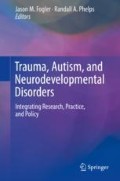Abstract
The roots are tangled. Can we prune the ramifications? As has been mentioned many times throughout this book, a diagnosis of autism can help a child to access valuable services, including habilitative therapies, family supports and respite, and funding. Given the power vested by our healthcare system in the ASD label, it is not surprising that wait lists for autism diagnostic assessments are intolerably long. As a result, children with ASD wait unacceptably long intervals to access the medical diagnosis, a key to crucial services. Meanwhile, many children without ASD, who have screened positively or who have various red flags, also wait in this long line, only not to be told they do not meet diagnostic criteria for ASD. Even those children who do not end up being diagnosed with ASD have significant difficulty with development and/or behavior, often with serious accompanying impacts on family functioning. In most cases, they will likely receive a diagnosis, and with this new diagnosis, they will usually be given some direction to go for assistance. Often, the diagnostic referral centers which provide ASD assessments are able to provide some interventions targeting this new diagnosis. Frequently, however, new referrals will be generated, and then there will be new lines to wait in, for different diagnostic assessments. This can be a very painful, trying experience for families, who may well have hoped, even expected, that they were nearing some diagnostic certainty at the end of their long wait. Finally, they thought, they would have a definitive diagnosis, and that diagnosis will finally open the vault to services their child has needed for a very long time. So, the question remains: can we improve this experience for our patients and families? Realistically, obtaining a diagnostic assessment for a child with developmental and behavioral problems is never going to be a “walk in the park.” But can we alleviate some of the confusion and discomfort, maybe prune back some of the hazardous low-hanging branches?
Access this chapter
Tax calculation will be finalised at checkout
Purchases are for personal use only
References
Centers of Disease Control and Prevention. International classification of diseases, (ICD-10-CM/PCS) transition—background. https://www.cdc.gov/nchs/icd/icd10cm_pcs_background.htmICD-10. Accessed 12 Feb 2017.
World Health Organization. International classification of functioning, disease, and health (ICF). http://www.who.int/classifications/icf/en/. Accessed 12 Feb 2017.
Feldman H. Redesigning health care for children with disabilities. Baltimore: Brookes; 2013. p. 70–71.
Lollar D. Launching into adulthood. Baltimore: Brookes; 2010. p. 52, 117.
Cuthbert BN. The RDoC framework: facilitating transition from ICD/DSM to dimensional approaches that integrate neuroscience and psychopathology. World Psychiatry. 2014;13(1):28–35. https://doi.org/10.1002/wps.20087.
Young G. PTSD, endophenotypes, the RDoC, and the DSM-5. Psychol Inj Law. 2014;7(1):75–91. https://doi.org/10.1007/s12207-014-9187-x.
World Health Organization. Towards a common language for functioning disability and health. Geneva: WHO; 2002. p. 9. Retrieved from http://www.who.int/classifications/icf/training/icfbeginnersguide.pdf; adapted by permission.
Author information
Authors and Affiliations
Corresponding author
Editor information
Editors and Affiliations
Rights and permissions
Copyright information
© 2018 Springer Nature Switzerland AG
About this chapter
Cite this chapter
Phelps, R.A., Fogler, J.M. (2018). Assessment and Recommendations. In: Fogler, J., Phelps, R. (eds) Trauma, Autism, and Neurodevelopmental Disorders. Springer, Cham. https://doi.org/10.1007/978-3-030-00503-0_13
Download citation
DOI: https://doi.org/10.1007/978-3-030-00503-0_13
Published:
Publisher Name: Springer, Cham
Print ISBN: 978-3-030-00502-3
Online ISBN: 978-3-030-00503-0
eBook Packages: Behavioral Science and PsychologyBehavioral Science and Psychology (R0)

